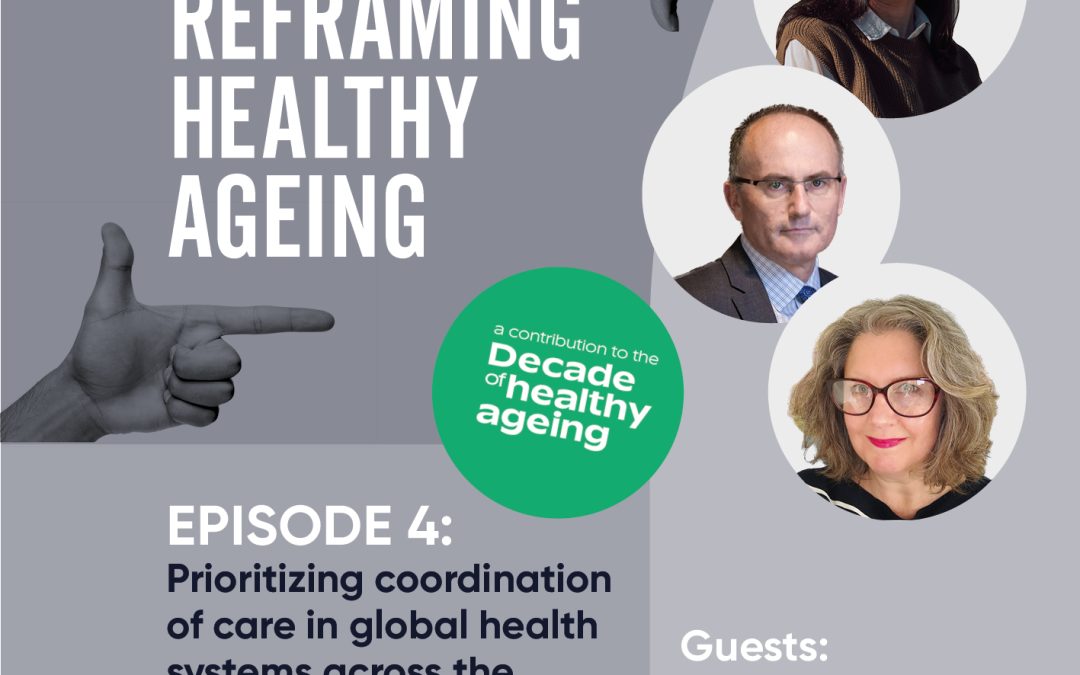In this episode of the Reframing Healthy Ageing podcast, IFA’s Dr. Jane Barratt is joined by Dr. Niamh Lennox-Chhugani, the Chief Executive and Director of Research at the International Foundation for Integrated Care, and Dr. John Muscedere, Professor of Critical Care Medicine in the Faculty of Health Sciences at Queen’s University in Canada and Scientific Director, and Chief Executive Officer of the Canadian Frailty Network, to discuss achieving integrated care to improve person-centredness, with a lens on frailty and bone health.
The COVID-19 pandemic demonstrated the fragility of our health systems and, as a result, many health care systems are in crisis. Overburdened health systems are marked by delayed or missed care, overworked health care providers and health systems struggling to return in full force to pre-pandemic levels. For example, a report by the Canadian Medical Association finds that in-person appointments for chronic disease management plummeted during the pandemic but have not returned to pre-pandemic levels. In the province of Ontario, the number of in-person visits ranged from roughly 60% less than before the pandemic for patients with hypertensive heart disease to 87% less for patients with diabetes as of January 2021.
Overburdened health care systems, delayed services coupled with already complex pathways to care make it difficult to access health care services. However, considering rapidly ageing global populations, it is no longer feasible to continue to rely on interventions only applied when the needs are great, capacity has declined, and loss of function is significant. This approach further burdens older people, caregivers, and health systems. A holistic health care approach, which prioritizes prevention, is required to support healthy ageing and rapidly ageing populations.
One of the key action areas of the United Nations Decade of Healthy Ageing (the Decade) is primary integrated care. The Decade recognizes that equitable and affordable access to quality care is central to fostering healthy ageing. In fact, a number of global agendas emphasize the importance of integrated and people-centred care. The World Health Organization launched Integrated care for older people (ICOPE), framework and guidance for holistic assessment and care of older people across various facets that effect function, including mobility, nutrition, vision, hearing, cognition, and mental health. ICOPE echoes goals set out in eye health and hearing health sectors, which aim to prioritize eye and hearing care services in primary care to increase screening, diagnosis, treatment, and rehabilitation.
With the many calls for integrated care, it is important to understand a few key questions. For example, what makes care integrated? How does it benefit people and health systems? How can integrated care be implemented and operationalized? This episode sought to answer these questions with an emphasis on the patient journey, and the protection of bone health and prevention of frailty to maintain function.
Understanding integrated care
The International Foundation for Integrated Care aims to advance science, promote and share knowledge and support the implementation and adoption of integrated care in policy and practice. As the Chief Executive and Director of Research at the International Foundation for Integrated Care, Dr. Niamh Lennox-Chhugani is a leading voice on what it means for systems to be integrated and promoting this integration.
Dr. Lennox-Chhugani explains that there isn’t a single definition of integrated care but rather four defining features of care: coordination, continuity, person-centredness and community-centredness. Dr. Lennox-Chhugani acknowledges that context is very important and integrated care may look different based on health systems, and social, political and technological context, but the four defining features result in systems that support many stakeholders.
“We know it gives better patient outcomes. We know patients have a better experience of care if it’s coordinated and continuous. We also know that particularly physicians and other health and care professionals working in primary and community services have much greater satisfaction in the work that they do and connecting with the people that they work with, their families and their communities if they are offering integrated models of care.”
A lens on bone health
Fostering person and community-centredness calls for a central focus on the patient journey and the barriers that people face in accessing timely and affordable care, enabling the operationalization of integrated care to support healthy ageing. Using bone health and frailty as a case study, Dr. John Muscedere outlines the journey and barriers that many patients face.
Dr. Muscedere explains that approximately a quarter of people over the age of 65 in Canada experience frailty and additionally have complex needs which may require medical, social and psychological support.
If we think about the steps required to foster healthy ageing, it begins with prevention. Often people are not well educated on the importance of bone health and preventive measures (nutrition, exercise) that can be taken to protect bone health and deterioration later in life. It is also difficult to diagnose early declines in bone health as people are not usually assessed for frailty or pre-frailty thus leading to irreversible changes that impact function. We often intervene when people are experiencing significant declines, adding to acute care system burden and normalizing the dependency of older people, increasing the need for long term care delivered either at home or in facilities.
According to Dr. Muscedere, developing integrated care systems begins with strong primary care in which multidisciplinary and holistic teams can be embedded. Dr. Muscedere explains “And so, the first thing is access to primary care. And we know in Canada that there’s large numbers of people who do not have access to primary care, which is probably the most important thing as the gatekeepers to the system. It’s not just primary care, it’s multidisciplinary teams that can be embedded in primary care. So, these are family health teams that include all the aspects that people as they grow older may need. So, for example, a physiotherapist, a nutritionist, pharmacist, all those things that address some of the problems that frail people may need.”
The value case for integrated care
Integrated care is important to patients and their loved ones, while also benefiting providers but how do we implement integrated care systems and make the case to policy makers that systems must be re-oriented to achieve greater coordination and patient-centredness? In terms of making the value case, Dr. Lennox-Chhugani highlights the fragile state of health systems during the COVID-19 pandemic.
“That argument [investing in primary and community services] has been made for us by the pandemic. So, I would put the austerity argument completely to one side and say, politicians and policymakers do not have an option right now unless they want us to go through the same cycle again. And one of the things that I will usually do when involved in advising at national and pan-national levels is, first of all, do some housekeeping. So, look at what in your system of your policy levers is incentivizing fragmentation. So, what’s getting in the way of coordination and continuity for patients and for their families? And remove those barriers first.”
A key theme across this podcast series is the need for multisectoral collaboration to achieve global goals. To achieve integrated care Dr. Muscedere and Dr. Lennox-Chhugani similarly emphasized the need for partnership, shared goals and relationships built on trust. Additionally, political will is important and it will be necessary to expand beyond the short-term nature of political cycles to reap benefits in the long-term.
Recommendations from this episode
- Health prevention is a priority to improve the health of populations and health systems and requires long term investments that extend beyond political cycles.
- Integrated care benefits patients, families and caregivers, health care providers and governments by enhancing satisfaction of care, supporting improved health outcomes and efficiencies, reducing health system burden and providing cost-savings. To support implementation of integrated care, governments must work to assess how they may be incentivizing fragmentation.
- Bone health and the prevention of frailty is central to healthy ageing and supporting ageing populations. The Canadian Frailty Network’s AVOID Frailty framework supports prevention of frailty by promoting activity, vaccination, optimization of medications, interactions, and diet and nutrition.

